Join us for conversations that inspire, recognize, and encourage innovation and best practices in the education profession.
Available on Apple Podcasts, Spotify, Google Podcasts, and more.
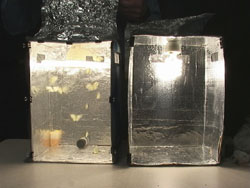
The Brassica & Butterfly System (see building instructions below) will allow you to observe an entire plant life cycle along with an entire animal life cycle over a relatively short time period. The plant, Brassica rapa, is a variety that belongs to the mustard family. It has been selectively bred for a rapid life cycle: from seed to seed in about 30 days. These plants have been nicknamed “Fast Plants.” The animal is Pieris rapae, an insect known as the cabbage white butterfly. Pieris also has a life cycle that occurs over about 30 days.
The connection between the two involves feeding and reproduction. Pieris larvae are particularly fond of eating Brassica leaves, while Pieris adults feed on the nectar in Brassica flowers. As the butterflies move from flower to flower, they pollinate the Brassica plants. In addition, Pieris adults are attracted to Brassica leaves for egg-laying.
There are many activities that can be done with Brassica, Pieris, or both. Life Science has suggested a few that can help you understand plant and animal life cycles better–and that can be used with great success in K-6 classrooms. The “Brassica & Butterfly Life Cycles” activity follows the progress of Brassica from seed to seed as it interconnects with the life cycle of Pieris from egg to egg. “To Bee or Not to Bee” is an activity you can do to see what happens to Brassica flowers that are pollinated and those that are not. The “Salad Bar” activity tests the feeding preferences of Pieris larvae; and in “How Sweet It Is,” different sugar concentrations are used to see the effect on adult Pieris feeding. Finally, with the “Mother Knows Best” activity, you can see on what types of plants Pieris prefers to lay eggs.
You can follow along online and “Track Our Progress” with these activities: “Brassica & Butterfly Life Cycles,” “The Salad Bar,” and “Mother Knows Best.”
For more information and activities for this system, visit the Fast Plants Web site at www.fastplants.org.
Your Brassica plants will need a place to grow undisturbed from seed to flower. To do this, you’ll need the following:
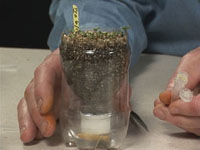

Pieris will need different components for different stages in its life cycle:
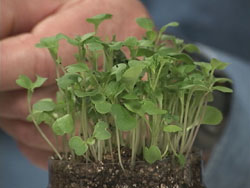
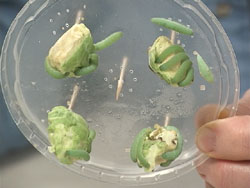
Depending on the activities you choose to do, you may need one or more of the following:
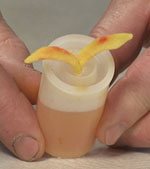
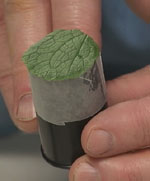
 Materials Needed
Materials NeededFor Building
For Stocking and Maintaining
For Building
Box unit:
Front panel: (Will be used when growing plants in Light House)
Front screen: (will be used when housing butterflies in Light House)
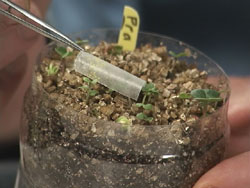 Instructions:
Instructions:For Building, Stocking, and Maintaining
See Bottle Growing System. The only difference involves the seeds used and the addition of Pieris eggs.
Seeds
The Brassica Nursery uses a variety of seeds to grow different plants to feed the larvae. Turnip, radish, and lettuce seeds can be purchased from a garden store and mixed together. Fast Plant seeds can also be used in the mix. The seeds should be planted about five days before the eggs arrive.
Eggs
Pieris eggs can be purchased from Carolina Biological Supply Company (1-800-334-5551 or www.carolinabiological.com). The eggs should be ordered to arrive about 5 days after the seed mix has been planted, so that the larvae will have something to feed on. When the eggs arrive, they will be on a strip of wax paper in a small plastic vial. With tweezers, remove the wax strip carefully and place it egg side down on the plant seedlings. Do not touch the eggs!
Note: During larval stages, Pieris should be kept away from the Brassica being grown in the Light House System. This will prevent them from eating plants that need to grow to the flowering stage.
 Instructions:
Instructions:For Building
For Stocking and Maintaining
Building, Stocking, and Maintenance Instructions
 The bee stick is used for pollinating Brassica flowers. The bee stick requires a dead bee mounted at the tip of a toothpick. You can purchase dead bees from Carolina Biological Supply Company (1-800–334–5551) or www.carolinabiological.com. Alternatively, you can find your own dead bee (or other flower-feeding insect), or use a fine paint brush.
The bee stick is used for pollinating Brassica flowers. The bee stick requires a dead bee mounted at the tip of a toothpick. You can purchase dead bees from Carolina Biological Supply Company (1-800–334–5551) or www.carolinabiological.com. Alternatively, you can find your own dead bee (or other flower-feeding insect), or use a fine paint brush.
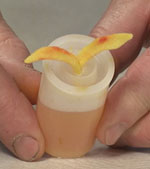 Materials Needed
Materials NeededFor Building and Stocking
Building and Stocking Instructions
 Materials Needed
Materials NeededFor Building and Stocking
Building, Stocking, and Maintenance Instructions
Now that you’ve built the components you need for the Brassica & Butterfly system, try these activities to further your understanding of this system. First, read the instructions and perform the activity. Then, for selected activities, view an example system in track our progress.
What happens during a typical plant life cycle? What about the life cycle of a familiar insect, like a butterfly? This activity explores the life cycles of Fast Plants, or Brassica rapa, and Pieris rapae, the cabbage white butterfly.
To prepare
When the butterfly eggs arrive
During the study period
Both life cycles will take about 30–40 days to complete. During this time, make observations every 2–3 days. Use your Brassica & Butterfly Data Sheets (PDF) to record what you observe and answer questions.
Visit www.fastplants.org for in-depth information on the Brassica and the butterfly.
Brassica questions
Butterfly questions
Brassica & Butterfly questions
TRACK OUR PROGRESS for the Brassica & Butterfly Life Cycles Activity
Fast Plants are pollinated by many insects, including Pieris rapae and bees. What is the role of pollination in a plant life cycle? What happens if flowers aren’t pollinated? Try this with the plants being used in the Brassica & Butterfly Life Cycles activity to find out!
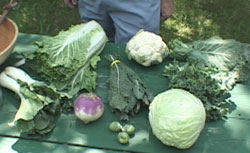 Are Pieris larvae picky eaters? Find out by providing them with their very own salad bar.
Are Pieris larvae picky eaters? Find out by providing them with their very own salad bar.
* Select from members of the Brassica family (cabbage, broccoli, turnips, pak choi, kale, mustard greens, etc.) and non-Brassicas (lettuce, beet leaves, celery leaves, carrot leaves, spinach, etc.).
TRACK OUR PROGRESS for The Salad Bar Activity
Adult Pieris feed upon the nectar of Brassica plants. Nectar is sweet, but is it possible that varying levels of sweetness might have an impact on Pieris feeding?
Adult Pieris feed upon the nectar of Brassica plants. Nectar is sweet, but is it possible that varying levels of sweetness might have an impact on Pieris feeding?
Do female adult Pieris butterflies prefer to lay their eggs on specific plant types? Find out by providing them with different types of plant leaves.
TRACK OUR PROGRESS for the Mother Knows Best Activity
Get a glimpse of our system at various points in selected activites. Remember that every system is unique: don’t expect yours to look exactly like ours!